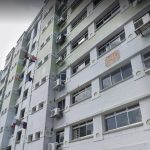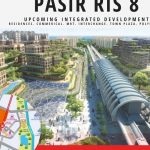Further property stabilization can be expected with robust demand for real estate says EDMUND TIE research

While the tightening of domestic restrictions and border controls in May 2021 represented a setback to segments of the Singapore economy, this was partially relaxed in June 2021 and the broader economy should recover in tandem with the global economic rebound and further progress in the domestic vaccination programme. An MAS survey of private-sector economists showed that Singapore’s GDP is tipped to grow 6.5% in 2021 led by manufacturing and export growth. Business and consumer sentiments are being lifted by the growing likelihood and normalcy of a COVID-19 endemic in the nation.
Further property stabilization – signs in investment sales
Investment sales in 2Q 2021 were led by the residential sector, which contributed $3bn followed by the industrial sector with $0.9bn, 56% and 17% respectively of the total investment sales. $1.2bn of residential sales were from the Government Land Sales (GLS) programme. As there was no land sale activity in 1Q 2021, the government’s sale of three residential sites in 2Q 2021 drew intense competition with seven to fifteen bidders per site.
EDMUND TIE’s senior director of research and consulting, Mr Lam Chern Woon said: “The continued recovery of transaction activities in 2Q 2021 demonstrates the robust demand for real estate. Amid the positive market outlook, there is intense competition especially amongst developers who are looking to replenish their land banks. We expect to see more activity in certain industrial sectors such as research and development. For example, Ascendas Reit has acquired the remaining 75% interest in Galaxis, a business park in One-North which houses key growth sectors such as biomedical sciences, information and communications technologies and media, science and research institutes.”
“Alongside the push towards advanced manufacturing, and with the increased availability of industrial land in 2H 2021, we expect an uptick of investment towards industrial properties,” he added.
Office Sector and Further property stabilization
Monthly rents in the various subzones of the office sector held steady or declined slightly in 2Q 2021. Within the CBD and Non-CBD subzones, there is a continued emphasis on a flight to quality office spaces while taking advantage of the current climate to negotiate better rates for office rentals. Overall, EDMUND TIE expects office rents to bottom out by the end of 2021.
Overall net absorption islandwide improved further from 185,000 sq ft in 1Q 2021 to 649,000 sq ft in 2Q 2021. This improvement was fueled by the decentralised regions, which experienced the highest positive net absorption, a testament to the trend of decentralisation, as more companies opt for spaces located outside the CBD.
Occupancy rates for CBD dipped by 0.7% pts q-o-q due to increased restrictions and companies re-evaluating their business operations needs due to Covid-19. Companies are rethinking their real estate footprint, with some preferring the “asset-light” approach. This approach enables them to have some cost savings from office rents, flexibility and the option to transform their office spaces into an avenue for collaboration and socialisation.
“The recent Phase 3 (Heightened Alert) curbs have resulted in working-from-home being the default arrangement in Singapore, resulting in thinner crowds at hot office spots,” Mr Lam remarked. “Landlord remain flexible to negotiate with tenants on rents and incentives, although the window for quality spaces may not be open for long as companies continue to favour quality stock,” he added.
“As companies reevaluate their office spaces and the economy gradually recovers, the trend of flexible workspaces is expected to continue, as seen from the bullish expansion plans of the co-working operator JustCo,” said Mr Lam, speaking on the trend of flexible workspaces.
“In March 2021, JustCo announced its plans to open an office in Tampines located at Asia Green and further announced in June 2021 that they will manage and occupy two floors at The Metropolis in Buona Vista, the only Grade-A office located in One-North precinct. Further office demand is bolstered by the Information and Communications, Finance and Insurance sectors. These sectors contribute to the increased demand for quality, flexible workspaces furthering buoying the demand for such workspaces,” he further remarked.
“Tenants are taking advantage of the Covid-19 situation to shift towards quality buildings, such as providing higher quality ventilation systems to create a safer and healthier work environment.” he added.
Industrial Sector and further property stabilization
The full-year trajectory for manufacturing remains sound, as the sector saw little impact from stricter Covid-19 measures during Phase 2 (Heightened Alert). Barring a worsening of the Covid-19 situation, the manufacturing sector is expected to be one of the key pillars of growth, as export-oriented industries ride on global trade growth.
Prices and rentals of industrial space are likely to remain stable for 2021 with the higher-than-average supply pipeline balancing off with improving demand.
The shift of food & beverage (F&B) sales online, triggered by Covid-19, drove the growth of a new trend of cloud kitchens. EDMUND TIE notes that cloud kitchens are an emerging niche market segment with significant growth opportunities. This is evidenced by Singapore-based Select Group’s announcement in March 2021 of their plans to invest S$10 million to open 20 cloud kitchens locally over the next five years.
Retail Sector and Further property stabilization
Islandwide net absorption improved to 301,000 sq ft in 1Q 2021 from 258,000 sq ft in 4Q 2020. The occupancy rate increased by 0.3% pts to 91.5% in 1Q 2021 from 91.2% in 4Q 2020.
The occupancy rate for the Fringe/ Suburban area improved by 0.8% pts to 93.3% in 1Q 2021. More retailers are showing a stronger preference in locating their shops at the Fringe/Suburban subzone due to the increased footfall primarily attributed to the default work-from-home arrangements.
Retail sales for furniture and household equipment, recreational goods, watches and jewellery and computer and telecommunications continued to grow year-on-year (y-o-y) in 1Q 2021. Restaurants’ sales registered a moderated improvement of -33.1% y-o-y in 4Q 2020 to a -6.3% in 1Q 2021.
As more retailers jump onto the bandwagon of setting up online stores to drive sales, Robinsons has recently announced that it will partner with Grab and return as an online department store. Remarking on the continued shift to online platforms, Mr Lam adds: “The Great Singapore Sale (GSS) is taking an omni-channel approach this year, and we expect even more retailers to reinvent and adopt this new form of approach in terms of driving sales. By partnering with platforms like Lazada, retailers can leverage on the ease of accessibility of applications and online platforms.”
“We see potential upside for retail rents in the Fringe/Suburban Areas, given the continued strong retail performance and the tight supply pipeline,” Mr Lam added. “Given the subdued tourism and office crowds, landlords with retail malls at Orchard/Scotts Road and Other City Areas are opting for a more flexible stance in terms of their commercial terms and giving greater priority to optimizing their trade mix.”
Residential sector and Further property stabilization
In 2Q 2021, the residential sector saw a total of 7,267 units change hands, which represented a dip of 10.3% q-o-q. New sales volume recorded a more significant decline of 18.5% q-o-q, compared to the secondary market volumes (4.1% q-o-q). Across the market segments, new sales volumes within the Rest of Central Region (RCR) and Outside Central Region (OCR) witnessed q-o-q declines of 40.9% and 2.3% respectively. On the other hand, new sales volume in the Core Central Region (CCR) witnessed a q-o-q growth of 16.6%.
The growth in new sales volume in the CCR was driven by the location of the new residential project launches of the year. There were nine significant launches of non-landed projects between January and end-May 2021, out of which five (Midtown Modern, The Atelier, Irwell Hill Residences, Peak Residence, and Grange 1866) were located in the CCR.
Based on URA’s flash estimate for 2Q 2021, the Property Price Index (PPI) for all private residential properties rose for the fifth consecutive quarter, albeit at a slower rate of 0.9% q-o-q versus 3.3% q-o-q in 1Q 2021. The PPI for non-landed private residential properties rose at a marginally faster rate than that for landed private residential properties. Across the various market segments for the non-landed properties, the price increase was the most pronounced in the OCR, at 1.8% q-o-q as compared to 0.6% and 0.3% for the CCR and RCR respectively. This trend indicates a strong demand for units in the OCR, against the backdrop of prevailing decentralisation and work-from-home trends.
In the private residential leasing market, total rental volumes declined marginally by 1.0% q-o-q to 23,622 transactions in 1Q 2021. However, there was a 9.0% y-o-y growth from 1Q 2020, suggesting a relatively stable rental market for private homes.
Speaking on the residential trends, Mr Lam said: “As the economic recovery gains traction, the demand for private homes will likely hold steady amidst a low-interest rate environment with ample liquidity.”
“Barring possible imposition of government cooling measures, the private homes market is likely to remain on sound footing with transaction activity staying robust. On the supply side, developers could continue to price new units at a premium to account for increases in construction costs resultant from a tight foreign labour market and delayed timelines due to COVID-19,” He added.






